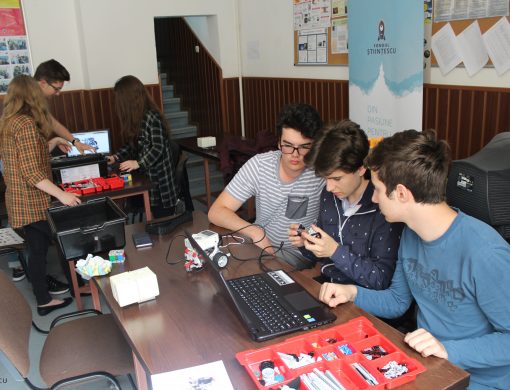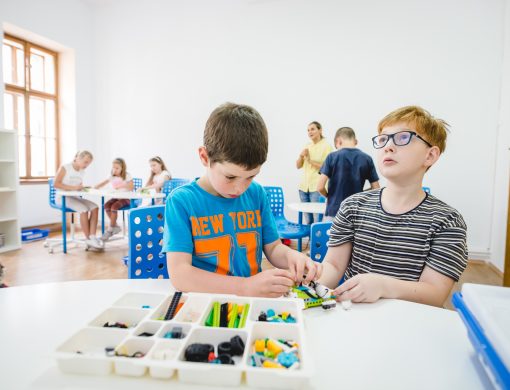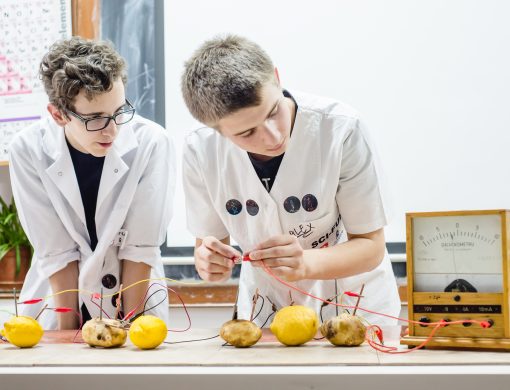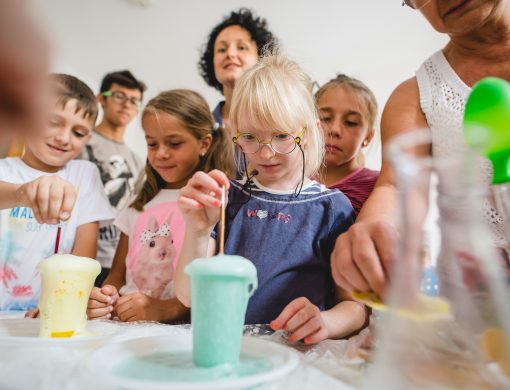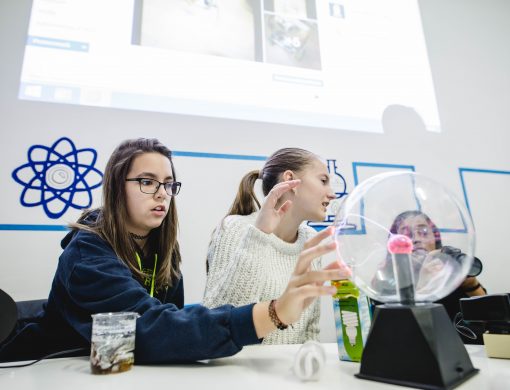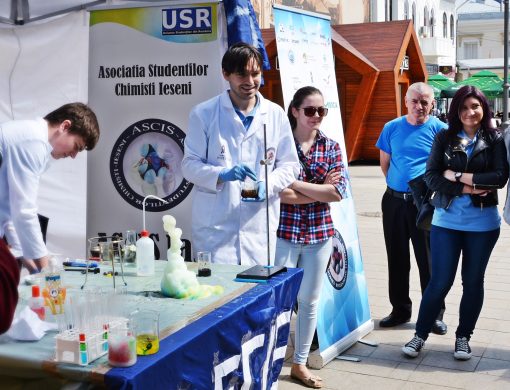By Mona Dîrțu
Text published in RAF’s 2016 Annual Report
“Physics is not only about formulas and formulas”
Here’s Legolas the Elf, for example – Orlando Bloom’s character from “The Lord of the Rings”. Some 30 seventh-graders from Iași, a city in North-Eastern Romania, try to help Legolas transport a bunch of weapons up a hill. Everybody knows Legolas is a fictional character, of course, but that doesn’t make the task less critical. And it’s not about grades this time. They’re simply playing with Legos – though, curiously, a formula from the physics textbook will prove wonderfully handy in finding the solution.
“This Legolas story disguises our intention, you know?”, says Florin Anghel, one of the three teenagers who created the Legolas problem to spice up Techno Brick 2, their extra-curricular project. “We tell the kids we’re going to play together with Legos, and that’s something they all love. But, besides playing, we want them to learn something”. For example, they can learn to solve an inclined plane problem by studying the dynamics of the Lego construction instead of decomposing the force vectors, as they were taught in school. “Physics is not only about formulas and formulas. It has a lot of practical stuff, but the children don’t always grasp this”, adds Rareș Crăciun, Florin’s colleague.
Florin, Rareș and Sabin Grigoraș – the last partner of the trio – invented the Lego-Legolas problem to upgrade Techno Brick 1, an engineering and robotics workshop they attended as students the year before. They loved the idea of reshaping the workshop from their half-student/half-teacher perspective, so they decided to add their own objective. “We wrote it down in the application. We wanted to show to both teachers and students how important the practical side of the sciences is, and how much the kids can learn when they see things”, Rareș explains.
So, did it work? “Yes”, says Florin. “One day, after the workshop, a kid came to me and said “Thanks, now I really understand what we’ve learned at school”.
A moment of silence interrupts the flow of the Techno Brick story. The boys look at one another and smile. That’s what learning is all about, isn’t it? Their hypothesis proved to be correct to the last letter: the kids learn more easily, indeed, “when they see things”. Quod erat demonstrandum.
And Techno Brick is just one of over one hundred little projects that tell the greater story of the Științescu Fund. It’s also a developing story: before Techno Brick 2 there was Techno Brick 1, a project created in 2015 by two trainers who liked the enthusiasm of Florin, Rareș and Sabin so much that they encouraged the three teenagers to take over the workshop and grow it further. To become teachers themselves, in other words. “There’s this concept of learn-practice-teach, you know?” says Florin. “That’s what we did; we just followed the steps of the concept”.
Mr. Științescu is born
The remarkable insights of these three teenagers might have never existed if it wasn’t for a little “what if?” question raised few years ago. “It was the autumn of 2014”, remembers Roxana Vitan, RAF’s President. What if we nurtured the revival of science education all across the country, we wondered, by funding, with the help of RAF and with money raised by the communities, little science projects for middle school kids – for thousands of them? “Because education is, in the end, a community’s responsibility”, she argues; “that’s something we, as a nation, have yet to learn”. And STEM education – an acronym for science, technology, engineering and math – is something we can’t afford, as a nation, to fall behind on.
So Roxana Vitan asked the question – “the seed of an idea”, as she describes it – of the community foundations and gave it enough space and time to germinate at its own pace. “There was only an idea back then, not a plan. We knew that before starting any serious planning, everyone should go back to their community and explore if – and how – it can be done”.
Fast forward to 2015. The little “what if?” embryo grew, inch by inch, until it took a life of its own in four cities – Sibiu, Iași, Cluj and Bucharest – where the Științescu Fund was first launched as a pilot project. What about the name of the fund? “Oh, it’s the community foundations that came up with the name”, says Roxana.
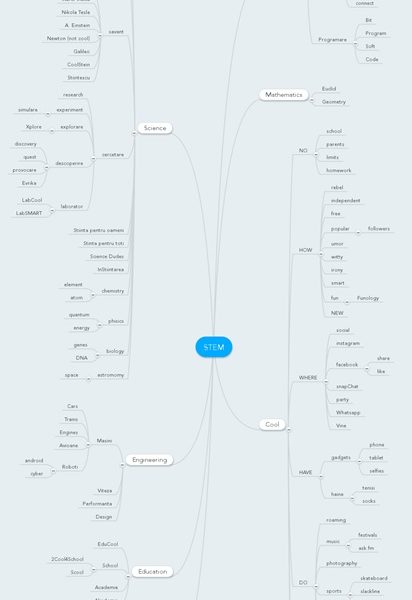
Ciprian Ciocan, the head of the community foundation in Sibiu, doesn’t remember who exactly came up with the Științescu name. “I only remember I wrote down a mind map with all the ideas that came to our minds. Do you want to see it?”. Of course I do; that mind map might be considered the project’s symbolic birth certificate.
Here it is: an indistinctive word document, A4, portrait. In the middle, highlighted in bright blue, the word STEM, surrounded by seven branches and a swarm of over 100 words in small font; “discovery”, “Eureka!”, “challenge” and “cool” are among them. On the left side of the page, a list of seven names, mostly scientists – including Tesla, Einstein and Newton (labeled “not cool” into brackets, as if this was his nickname). The last of the seven listed scientists? Someone nobody ever heard of: Mr. Științescu.
For a Romanian native, the name “Științescu” doesn’t need much of an explanation. It comes from “știință”, the Romanian word for “science”, and “-escu”, a frequent ending for family names. The most common Romanian name? Ionescu. The most celebrated poet? Eminescu. The most revered composer? Enescu. The last communist president? Ceaușescu. The first post-communist president? Iliescu.
Local flavors
Fast forward to 2016. Under the umbrella of this single, unifying name, a spectacular diversity of passions and creative ideas blossomed during Științescu’s first years. As 2017 dawned, eight other cities launched their own Științescu Fund, adding to the initial four. The list of funded projects grew from 42 during the pilot phase to over 100, and among those who applied were science teachers, active and retired, from both towns and villages; students; engineers; all sorts of people who love science and technology, including a kinetic sculptor from Cisnădie, a small town near Sibiu; and a librarian from Cotnari – a village famous for its wine – who literally aimed for the stars and organized an astronomy club.
Each community foundation raised money to fund the projects in different ways. In Sibiu, for example, Ciprian Ciocan activated his network of partners from other projects, many of them local entrepreneurs. He used to be an entrepreneur himself before 2012, when he left his web development business to become executive director of the newly established community foundation. In Iași, where one of the main financial backers withdrew from the project, the team decided to raise the money by organizing an athletics event modeled on the Swimathon formula, remembers Ciprian Păiuș, who heads the local community foundation. “That’s how we hit the jackpot in the first year: companies ended up sponsoring the event, which gave them more visibility than the fund itself – and some of them even matched the money raised by their employees, who registered in the competition as runners”, says Păiuș. The bottom line: in Iași, the pilot was financed mainly by individuals, not by corporate donors.
There are, also, various other specificities. Științescu Iași, for example, encouraged projects from villages, aiming to spread the idea of STEM into smaller communities. The Sibiu team decided to help establish the flagship Științescu Hub, a place where most of the workshops take place today – some of them are paid, so the hub is also testing an incipient business model that may someday cover its operating expenses. They also created, in Sibiu, a special fund dedicated to students who want to teach sciences to kids – and they christened it, naturally, Științescu Jr.
“The sciences are not as boring as the kids thought”
One of Științescu Jr.’s success stories is Sci-Fun, now in its second year. It started in 2015, when a handful of ninth-graders led by Daniel Popescu – Dani, as everybody calls him – imagined “a four-day festival dedicated to light”. Why light? Because 2015 “is considered the international year of light”, explains the application form. They got the funding, and as a result they combined in a “best of” list the most spectacular experiments they had heard of. Three sciences were covered in their “festival”: biology, chemistry and physics.
The “Octavian Goga” high school, where they are students, provided the school lab and – at the beginning – some adult supervision. Științescu Jr. provided, along with assistance in planning the project, the money for the substances and materials: $208 in the first year and $304 in the second.
The team’s main ambition was to let the sixth-graders make experiments with their own hands, when possible. After two years of Sci-Fun, they’re happy with the results: they proved to almost 250 gymnasium kids that the sciences are not as boring as they thought. It wasn’t always easy, of course. “One company wouldn’t sell us the substances”, says Andrei Mariș, who joined Dani’s team during Sci-Fun’s second year (when they also changed the “light theme” to “the four elements”). “When they saw that we’re only 16-years-old, the companies were afraid to sell us substances, I guess”.
The right ecosystem
If Științescu were a real teacher, what would he be like? Probably someone who teaches you more lessons than listed in the standard curriculum. Everybody learned while working to bring life into the project. The community foundations, for example, answered along the way the “what if?” question from 2014. There are indeed, in their communities, people who resonate with the idea of developing and funding small educational projects for kids, “an abundance of little initiatives locally grown, and financed by the community”, as Suzana Dobre, RAF’s program director for education, describes them.
Some of the community foundations also learned to run a larger, more complex program. “Științescu was an opportunity for us, at the Iași community foundation, to improve our grant making processes, for example”, says Ciprian Păiuș.
The teachers, in turn, learned that there are still a lot of things that can be done, despite the scarce resources provided by the public education system. “Some middle-aged teachers from the village of Valea Lupului told me that with Științescu they did things they were dreaming of in college”, says Ciprian Păiuș.
The students learned teamwork, how to write a project, how to keep the costs in check and, crucially, how to manage a group of enthusiastic, noisy kids playing scientists. They have also improved, thanks to Științescu, their presentation skills. “And we understood why our teachers don’t do more complex experiments in the classroom”, says Dani Popescu from Sci-Fun. “The substances are so expensive, and they get such little funding; we never thought about that before”. Some of the kids even learned surprising concepts that have nothing to do with the sciences. Dani and Andrei for example, say they cannot apply next year with a new version of their workshop, as they’re now part of YouthBank, another project run by the Sibiu community foundation. “We would be in a conflict of interest”, explains Dani. They both laugh when they hear out loud those two words. Who would have thought you can learn this kind of stuff before graduating high school?
The Științescu Fund grew some healthy roots during the past few years, that’s for sure. Can it nurture a revival of STEM education in Romania? It’s too early to say, obviously. It takes years to answer such a question – and even if STEM education will blossom again in Romania someday, we may never know how much Științescu contributed. What’s certain, for now, is that twelve of the community foundations tested, in real life, their power to aggregate community resources and redirect them to a multitude of community-generated educational projects. Some of these projects have a good chance to live on without the funding from Științescu – and to coagulate around various science “micro-communities”, as Ciprian Păiuș calls them. “We’ve designed an ecosystem in Sibiu for these kind of independent initiatives to emerge”, says Ciprian Ciocan. “We don’t know what they will look like in the end – and that’s irrelevant, anyway”.
It takes a village to raise a child, they say. It might well take a community to raise a scientist.
Roxana’s Note: We know it’s confusing, but there is no mistake. Both executive directors are called Ciprian. It was not an eligibility criterion; it just happened.




